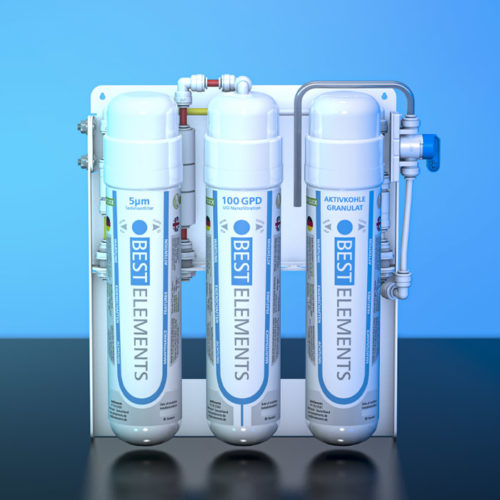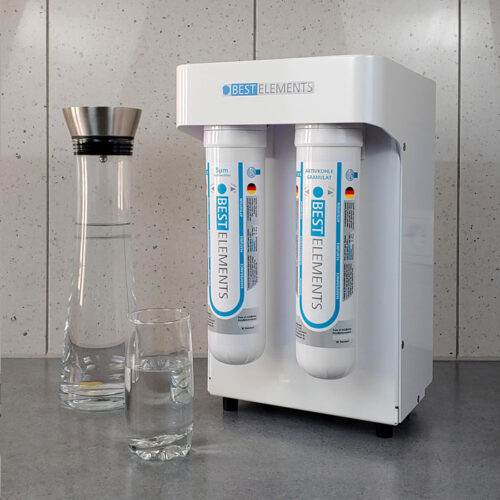Almost all regions of our country are potentially affected by drinking water contamination and drinking water warnings and water alerts are issued almost daily in our country. In frequent cases, this concerns bacterial contamination, contamination with PFAS, nitrates and pesticides from agriculture, heavy metals, chemical substances and residues of medicines and drugs.
Problem trifluoroacetate (TFA) in our environment
The substance trifluoroacetate (TFA) was discovered during drinking water tests and examined in more detail using a Global 2000 study. All samples showed “an alarmingly high level of contamination by the eternal chemical trifluoroacetate (TFA)”. According to the Federal Environment Agency, trifluoroacetate (also trifluoroacetic acid) is a very difficult-to-degrade chemical from the PFAS group that can accumulate in many areas of our environment. TFA has been detected in various regions, even in schools and mineral water bottles. TFA is used in medicines, pesticides and coolants, accumulates in water and does not break down. The substance is considered toxic to humans and animals, even algae die on contact. According to Stern magazine, “the chemical TFA is poisoning our water forever”. The TAZ writes about the chemical contamination in water that TFA could make people infertile, although the effects on humans, animals and the environment have not yet been fully clarified, but the water is at least contaminated across the board. Tests with high doses of TFA showed growth disorders and deformities, which underlines the potential danger of the substance. According to test reports from the International Commission for the Protection of the Rhine (ICPR) in Koblenz, reverse osmosis filter devices would remove the substance TFA from drinking water. Filtering with flow filters such as sediment, activated carbon or UV filters would therefore not be sufficient.
Problem PFAS in our environment
TFA is a PFAS chemical. A study by the University of Padua shows that the PFAS group of chemicals increases the risk of dying from cardiovascular disease. These so-called eternity chemicals have long been suspected of promoting various health problems such as cancer, diabetes and behavioral disorders. Here we take a closer look at PFAS.
The German Federation for the Environment and Nature Conservation (BUND) found in studies that the eternity chemicals can be found everywhere. PFAS is the most common, but melamine, trifluoroacetic acid and other very long-lasting chemicals that do not belong to the PFAS group as well as hormonal pollutants have been detected in mineral and tap water. Melamine, which is probably carcinogenic, has been detected several times. The BUND has published a map of Germany on which PFAS contamination can be viewed by region.
MRI contrast agent gadolinium in drinking water, COVID-19 effects
Recently, strikingly high concentrations of gadolinium, a rare earth contrast agent, have been detected in drinking water. Gadolinium is used in contrast agents for MRI examinations and is excreted after administration to COVID-19 patients. Since sewage treatment plants cannot remove this gadolinium, it enters rivers, lakes and ultimately groundwater and drinking water via wastewater. Currently, the gadolinium concentrations are still considered harmless to humans, but further research could produce alarming results. They could also be an indication of the possible presence of other, more dangerous pollutants in drinking water.
Drug residues in drinking water
The statement by a state parliament spokeswoman is worrying: On the one hand, there is no obligation to test for drug residues, but on the other hand, in North Rhine-Westphalia, for example, drinking water has been found to be highly contaminated with drug residues. According to a report by NDR from 2020, traces of Diclofenac and other residues were also found in drinking water.
Problem of antibiotic resistance
Antibiotics have already been detected in drinking water and a study has found extremely high concentrations of antibiotics in production wastewater. (Media such as Zeit and Bild reported on this). This means that antibiotics can spread through the population via drinking water and can lead to the development of resistant bacteria. In Germany, 33,000 people die every year from infections caused by bacteria against which no medication is effective. Worldwide, 1.3 million people die every year from infections for which antibiotics are no longer effective because the pathogens have become resistant. These results are alarming and pose a significant threat to health. Environmentalists are calling for urgent measures to reduce the environmental impact of antibiotics and prevent the development of further resistance.
Fear and suspicion of sabotage in drinking water
Recently, there have been increasing reports of possible acts of sabotage in connection with drinking water in various regions. These reports are causing uncertainty and fear among the population. Authorities are investigating various incidents in which drinking water may have been deliberately contaminated. Suspicions of sabotage are being taken seriously, as drinking water is one of the most important resources for public health. Official security measures are being taken to monitor water quality. Current developments show whether these efforts are sufficient to effectively protect the population in an emergency.
Mineral water tested: critical substances discovered
Consumer protection groups have found substances in 14 different mineral waters that have been classified as harmful, including pesticide degradation products, uranium and nickel. Although legal limits have not yet been exceeded, “Öko-Test” has already criticized the values that were over 50 percent of the permitted limits on the grounds of preventive consumer protection. The pesticide traces do not pose an immediate danger, but they are not “originally pure”. These results raise questions about the purity of mineral water and emphasize the need to monitor quality standards more closely to ensure that the water is as pure as we humans require.
Sources in the article and on request

One could lose courage with the constant reports about environmental damage and the poisoning of the environment through human actions. We are poisoning resources that are irretrievably present on our planet and only in limited quantities and that we urgently need for our lives. It is said that the water we drink today has already been drunk and excreted 7 times in the course of the earth’s history. And it has been purified again and again. With the contaminants mentioned in the article, this is unfortunately much more difficult and time-consuming, if at all possible globally. A rethink and a new remuneration system would be necessary to prevent such poisoning by ourselves in the future.
There is probably still a long way to go. And until that time comes, we at BestElements are doing a lot to remove contaminants from drinking water and shower water, to restore the air purity in your homes and businesses, and to enrich the water with hydrogen or to inhale hydrogen. All the best for your health! We are happy to answer personal questions.

















